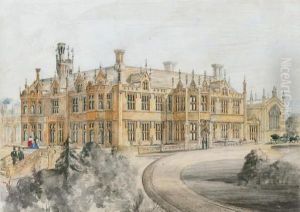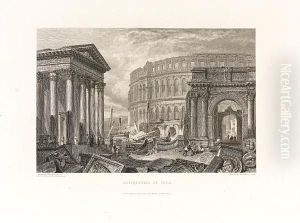Thomas Allason Paintings
Thomas Allason was an English architect and landscape designer, born in 1790. His career is noted for its contributions to the Regency and early Victorian architectural styles, blending innovation with the classical traditions that characterized the period. Unfortunately, not as much is known about his early life and education compared to other architects of his era, but Allason's work has left a lasting impact on London's architectural landscape.
Allason's professional life gained significant recognition in the early 19th century when he was appointed as the architect for the Ladbroke Estate in Notting Hill, London. This project allowed him to demonstrate his skill and vision, as he was instrumental in planning the layout of what would become one of the most fashionable residential areas in London. His designs often featured classical elements, and he was adept at integrating landscapes with built environments, which was a relatively novel approach at the time.
Among his notable works is the design for Ladbroke Square and its surrounding terraces, which remain iconic examples of Regency architecture. His ability to create cohesive urban spaces that combined elegance with functionality was remarkable. Additionally, Allason had a keen interest in the picturesque movement, which influenced his approach to landscape design. This is evident in his work on the grounds of various country estates, where he skillfully balanced natural beauty with architectural elements.
Thomas Allason's contributions to architecture and landscape design were not limited to residential projects. He also engaged in civic projects and was known for his plans to redevelop parts of central London, although not all of these were realized. His vision for urban planning and development, however, influenced later generations of architects and urban planners.
Allason's career was marked by a blend of architectural innovation and a deep respect for classical traditions. His work in Notting Hill and beyond has had a lasting impact on the London landscape, making him a notable figure in the history of British architecture. He passed away in 1852, leaving behind a legacy of elegance and thoughtful design that continues to be celebrated today.

